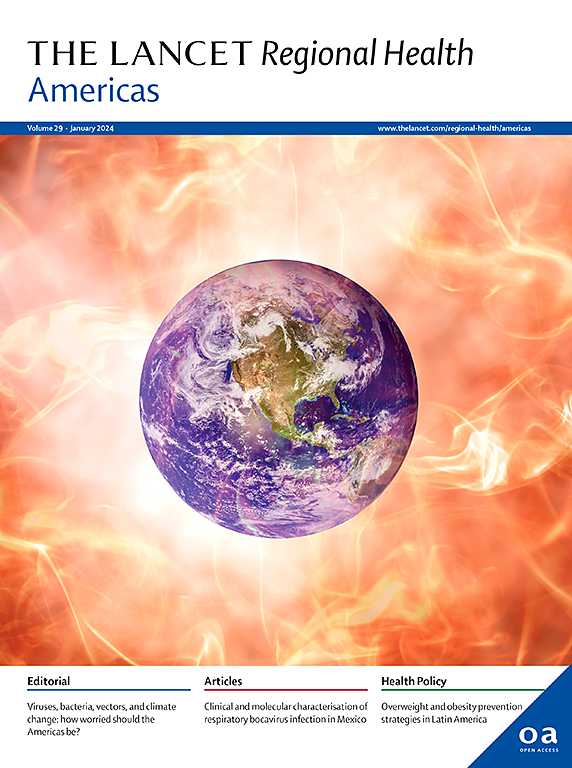世界上报告的最南方本土登革热暴发的特征(阿根廷布兰卡市Bahía, 2024年1月至6月)。横断面研究
IF 7
Q1 HEALTH CARE SCIENCES & SERVICES
引用次数: 0
摘要
登革热是一种媒介传播的病毒性疾病,它正在扩大其边界,在以前没有记录登革热的地方引起疫情和本地病毒传播。其目的是从流行病学角度描述有史以来在地球最南端纬度首次爆发的登革热。方法于2024年1月1日至2024年6月10日在阿根廷布宜诺斯艾利斯Bahía Blanca报告登革热病毒流行。已发现病例并向阿根廷布宜诺斯艾利斯省Bahía布兰卡市卫生秘书处报告。这些病例均经临床诊断,登革热病毒(DENV)非结构蛋白1 (NS1)、RT-PCR和/或IgM检测呈阳性。当患者在出现症状前15天未报告前往登革热流行地区时,病例被归类为本地病例。所有血清学和分子分析均在市医院进行。本研究使用临床样本和疫情期间获得的数据进行,排除了所有个人标识符。在470宗怀疑个案中,共报告94宗阳性个案。在确诊病例总数中,63例为本地病例,28例为输入病例。两例均检测到DENV1和DENV2血清型。在第二个流行病学周发现首例本地病例,在第13个流行病学周出现流行曲线峰值。27例输入性病例来自存在本地病毒传播的阿根廷地区,1例来自巴拉圭。这项研究提供了明确的证据,表明登革热已扩展到以前未包括在阿根廷风险图中的纬度。报告登革热向新地区蔓延的情况应提醒决策者采取旨在减轻该疾病负担的公共卫生政策。lsb、GGB和RS的部分资金来自国家科学和技术发展委员会(CNPq)和巴西卫生部科学、技术、创新和卫生综合体秘书处(DECIT/SECTICS/MS)的第18/2023号呼吁。LSB还接受FAPERJ (E-26/201.277/2021)和CNPq(310530/2021-0)的研究资助。本文章由计算机程序翻译,如有差异,请以英文原文为准。
Characterization of the most austral autochthonous dengue outbreak reported in the world (city of Bahía Blanca, Argentina, January–June 2024). A cross-sectional study
Background
Dengue is a vector-borne viral disease that is expanding its boundaries, causing outbreaks and autochthonous viral circulation in places where it had not previously been recorded. The aim is to describe epidemiologically the first outbreak of dengue in the southernmost latitude of the planet ever recorded.
Methods
In Bahía Blanca (Buenos Aires, Argentina), dengue virus circulation was reported between January 1, 2024, and June 10, 2024. Cases were detected and reported to the Health Secretariat of the Municipality of Bahía Blanca, Province of Buenos Aires, Argentina. The cases were clinically diagnosed and tested positive for dengue virus (DENV) nonstructural protein 1 (NS1), RT-PCR, and/or IgM. Cases were classified as autochthonous when patients did not report traveling to areas with dengue circulation during the 15 days prior to the onset of symptoms. All serological and molecular analyses were performed at the Municipal Hospital. This study was conducted using clinical samples and data obtained during the outbreak, and all personal identifiers were excluded.
Findings
A total of 94 positive cases were reported out of 470 suspected cases. Of the total confirmed cases, 63 were classified as autochthonous and 28 as imported. Serotypes DENV1 and DENV2 were detected in both cases. The first autochthonous case was identified in the second epidemiological week, and the peak of the epidemic curve occurred in the thirteenth epidemiological week. Twenty-seven imported cases came from Argentine locations with autochthonous viral circulation, and one came from Paraguay.
Interpretation
This study provides clear evidence of the expansion of dengue fever to latitudes that were not included in previously published risk maps for Argentina. Reporting on the expansion of dengue fever to new areas should alert decision-makers to adopt public health policies aimed at reducing the burden of the disease.
Funding
LSB, GGB, RS were partially funded by the call 18/2023 by the National Council for Scientific and Technological Development (CNPq) and the Department of Science and Technology of Secretariat of Science, Technology, Innovation and Health Complex of Ministry of Health of Brazil (DECIT/SECTICS/MS). LSB also acknowledges research grants from FAPERJ (E-26/201.277/2021) and CNPq (310530/2021-0).
求助全文
通过发布文献求助,成功后即可免费获取论文全文。
去求助
来源期刊

Lancet Regional Health-Americas
Multiple-
CiteScore
8.00
自引率
0.00%
发文量
0
期刊介绍:
The Lancet Regional Health – Americas, an open-access journal, contributes to The Lancet's global initiative by focusing on health-care quality and access in the Americas. It aims to advance clinical practice and health policy in the region, promoting better health outcomes. The journal publishes high-quality original research advocating change or shedding light on clinical practice and health policy. It welcomes submissions on various regional health topics, including infectious diseases, non-communicable diseases, child and adolescent health, maternal and reproductive health, emergency care, health policy, and health equity.
 求助内容:
求助内容: 应助结果提醒方式:
应助结果提醒方式:


